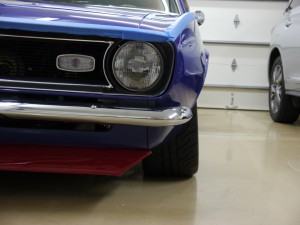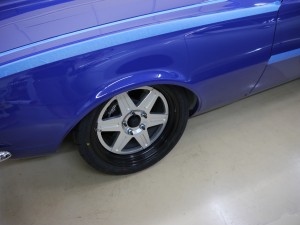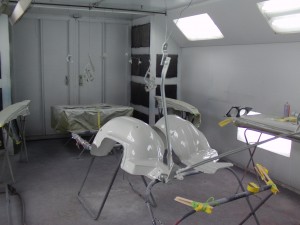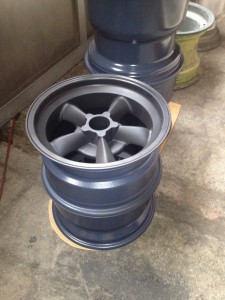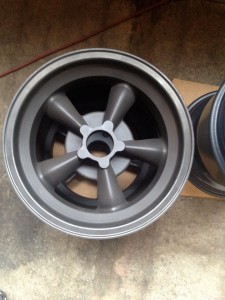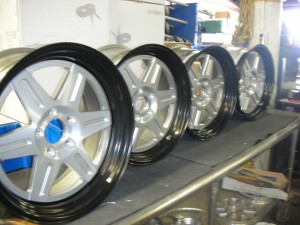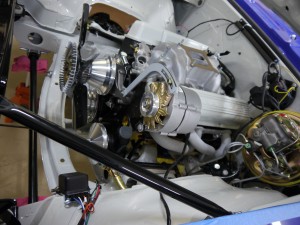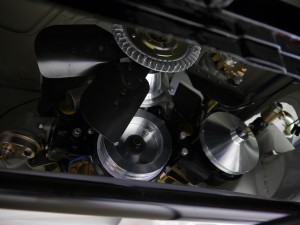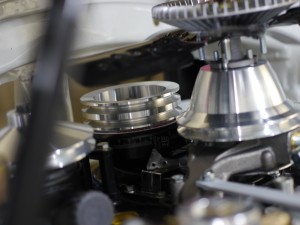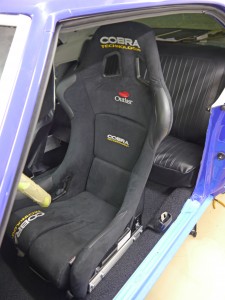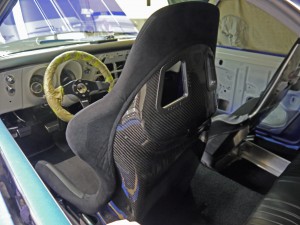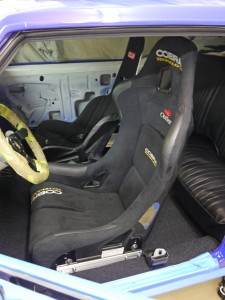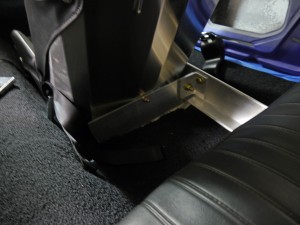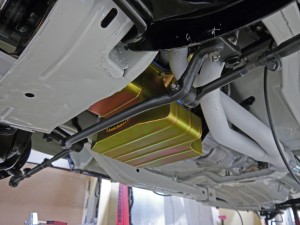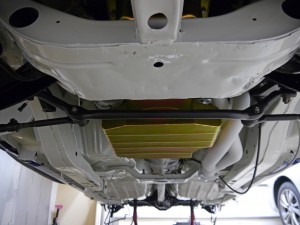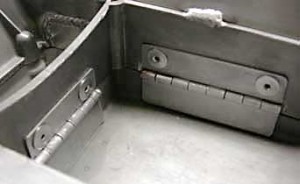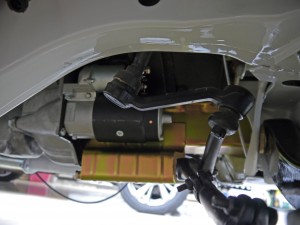You sunk my battleship
In part 4 of Comparative Vehicle Dynamics we went through looking at the key variables contributing to lateral grip and skidpad performance. Both these things are very important in autocross, where you spend the vast majority of time at the car’s lateral limit.
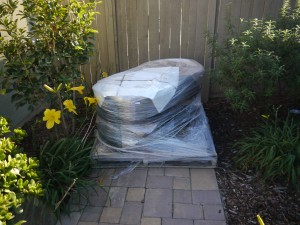 (Wheels and tires arrived on their own pallet, very nice!)
(Wheels and tires arrived on their own pallet, very nice!)
One of those key variables is track width – the wider, the less lateral weight transfer, and the more potential grip at the axle. This width ends up costing later in transitions, but my preference is still to take the wider track width, especially on a car that is somewhat under-tired compared to its competition. Especially too in the front, where the width tends to be a bit more manageable through slaloms. Especially three, in a car that has craptastic front suspension geometry, no ABS, etc.
When measuring for front wheels, most of the look-see was done at ride height, with the camber values around -1. I knew I’d run more negative for racing, but on the weird chance I ran more straight-up for the street or whatnot, wanted to be sure the wheel/tire wouldn’t be out of room outboard; a wheel too far inset can be pushed outward easily with spacers – ones too far outboard, require the use of those hard-to-find “negative displacement spacers” 😉
It looked like 5″ backspace might just barely be not enough backspace in front, and since it was easiest to step in .5″ increments, went with 5.5″ front backspacing. This was a bit of a bummer, since 5″ looked perfect (and after delivery still appears perfect) for the rear, meaning the front and rear wheels would (and do) have different dimensions.
When putting the car back on the ground for the first time in forever, I had the front suspension at its full -6 degrees camber. While the exact amount varies based on tire diameter and where you are already aligned, in general, for every one degree of negative camber you add, you move the top of the tire inboard by about .1″. So by adding over 4 degrees more negative camber from where I was when first measuring for wheels/tires, I moved the top of the tire inboard by over .4″, almost half an inch.
In the 240sx world when I owned mine, some people worked to get their wheel/tire combination pushed every last bit out to the limits inside their fenderwells. Tires so close to metal, you’d swear there’s no way they’d clear as the suspension moved, yet somehow they did. This was the pursuit of “flush stance” and those that achieved it were “hellaflush”. While this pursuit is mostly for looks, I happen to generally agree with the idea, as the further outboard you go, the more you’ve widened the track width. When done right, I think it looks good.
For every trend that gets branded, the opposite of the trend has to get branded too, and those that ran wheels/tires with too high an offset, or too much backspace, were said to have “sunken battleship” – because the wheel/tire appeared sunken into the wheelwell when viewed from the side. That’s how the Camaro looks with this backspacing – ugly and certainly not hellaflush!
I have some wheel spacers to go buy now for sure. Won’t be able to get the wheel/tire all the way out to the outer edge as is the modern style, with this car under the ST ruleset. The wheelwell is made of metal, and there is no allowance for its modification. Just inside of the outer blue fender, the inner fender has a flat plane for 1″ or so, before it forms a bowl shape upward. You can see it somewhat here, the wheelwell on the right has its outer portion facing the camera (inner portion is not a problem):
Because of this, the front of the car would either have to be up really high (blech!) or have a bit of the sunken battleship. I believe the wheels can go outboard at least 1/2″ from the above, possibly up to 1″ per side. Based on some Photoshop pixel math, it looks like the wheels need to go outboard 1″ to have the outer portion of the tire at the ground in line vertically with the exterior fender lip.
In addition to the extra track width on the end that needs it, this has the additional benefit of allowing for a bit more steering lock before the tires start to rub the frame inboard. But most importantly it should look much much better!!!
Would have a profile shot of the whole car on the ground at this point, but it looks ridiculous, as the rear springs are about 3″ too high. Like a wonky dragster, but worse. New rear springs are on order but will take while…ugg…
Few random pictures – two sets of wheels & engine compartment
Some of the prettier aspects of the car should be coming together soon. These first two are of the Vintage Engineering magnesium wheels, after coming back from receiving their DOW 9 coating.
Ray at Vintage then drills for the Camaro bolt pattern, and removes the coating from the outer lips with a scotch-brite pad on a lathe. When done they look like the other two I’ve already received. When they’re all here, will get the vintage-style Avons mounted up and put on the car.
Those are just for the street and any show-type activities though. The ones below are the real deal race wheels. 18×9″ Jongbloed 214 Aero, with custom backspacing, different front and rear.
Jongbloed mounted up my first set of brand new shaved ST tires on those today, should have them this week. Congrats to Mike Heinitz for correctly identifying the wheel pattern after I showed them in process back here.
Below are a few of the engine compartment, coming together, for real this time! 🙂 The March Performance pulleys look really great – they add a pop of shine without the obnoxiousness of chrome, and don’t betray the simple mostly-stock, all-business look I’m after.
With any luck I’ll have some rollers on this thing for some out-in-the-driveway shots this weekend.
Front seats in
Another project that was a bunch more work than anticipated!
Driver’s seat I’ve had sitting on a shelf for a long time now. In the early days of part searching, came across my favorite autocross seat for sale – the Cobra Suzuka Technology.
It’s my favorite, because the Suzuka design offers superb lateral support, without all the big head-restricting elements found in dedicated roadrace seats. I ran a Suzuka in my 240sx and loved it. You can also pull out the bottom seat cushion to get even lower, which is great on course, then put it back in for extra comfort on the drive home.
This is the fancier “Technology” version, that they only make to order. I found it second-hand, but brand new and never installed, from an NSX owner. The Technology version features carbon-fiber construction vs. Kevlar, has more durable wearing materials, and uses the same sort of fancy shape-remembering foam used in F1 cars. A cool seat!
The seat mounts took a couple revisions. The bottom of this seat is a bit wider than most, so the popular brand Wedge Engineering said they couldn’t make brackets for it, after a couple calls. Instead, I bought a pair of Sparco’s universal sliders and fabbed the mounts myself. The seat is as low as it can get, while still allowing the slider lever mechanism to lift enough to let the seat move.
Hard to tell if it’s low enough, with the car still up in the air on jackstands. If not, I’ll have to forego the sliders, and attach it in a fixed position. I’m really not that tall (~5’7″) but like to sit lower and a bit further back while autocrossing than most people my height.
One advantage of going to fixed position for the driver’s seat, would be the possibility of the seat mount stiffening the car up a bit. For the passenger side I went with a classic Kirkey seat, again repeating what I did in the 240sx.
The Kirkey is great for a few reasons. It is easy to mount – basically pick your spots, drill some holes, and you’re done. It works great as a bucket for carrying things to/from events – pretty much every tire sprayer I’ve ever used leaks, but with it sitting in the passenger seat, the leak is contained in the seat itself, which is easy to dry out by removing the cover. Since it is aluminum, should be easy to attach a camera mount to when that time comes. It’s quite light at a bit over 16 pounds with cover. And lastly, it’s cheap!
In mounting, tied the beefy angle aluminum into the four factory mount points, in addition to a couple other secure spots. In ST our seat and mount combinations have to weigh at least 25 pounds, so this is a place where adding 9-10 pounds of bracing doesn’t come at any net weight cost the way “steelitis” items like the subframe connectors do.
This thing isn’t going anywhere in an incident! Have some future plans to add additional bracing for the “seat” but this is good enough for now.
Oil pan
Whew, that was a bear. Too bad ST didn’t allow aftermarket oil pans in 2010 when I had the motor built, or 2011 when I put it in… 😉
An oil pan swap can be done with the engine in the car, but it’s a bit of a pain, have to remove some things, jack it up under the old pan, use block to get it to stay up high, swap pans, and then lower back down.
Was able to get the stock pan off without too much trouble, but the aftermarket pan I ended up using from Milodon, hangs down a bit lower than stock, requiring the motor be raised even further. Underside of the car as it looks today:
This pan has an increased oil capacity from stock (7 quarts vs. 4), left and right-side kick-outs (lots of circle-track stuff out there with only right-side), and three internal trap-door baffles. Here is a photo illustrating the concept (courtesy this Alfa Romeo site):
The principle with these doors, is they all hinge into a small central area where the oil pickup is located. They keep oil from rushing out as g-forces build in braking, cornering, or accelerating, and allow oil from the perimeter reservoirs to push the door open and flow into the pickup area.
Even with as old and simple as this car is, there is still some fairly tight packaging at work. The pan gets very close to the steering, the headers, the monstrous stock starter, has a cutout for an oil filter, and just barely tucks up higher than the stock crossmember, while still being a little deeper than the stock pan.
With all its tricks, the pan should go a long way in helping ensure a steady supply of oil to the pump in big corners. Between the weight of the pan and extra oil there’s probably another 10 pounds on the nose of the car, uggg, but I’ll take it as good insurance. Will probably still run the Accusump accumulator at non-SCCA events for that extra measure of protection.
